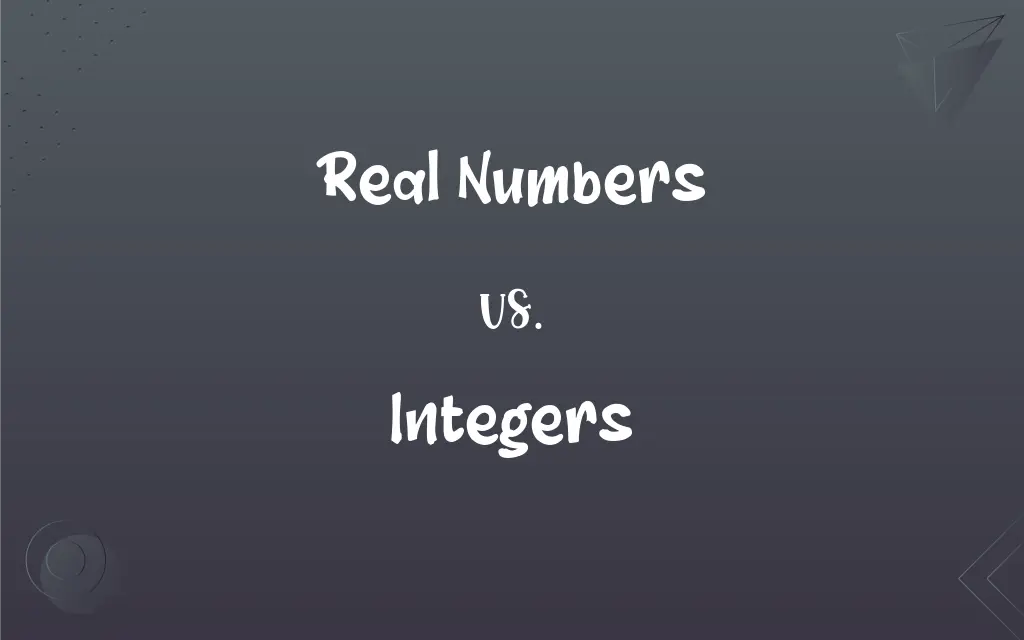Real Numbers vs. Integers: What's the Difference?
By Janet White || Published on November 18, 2023
Real numbers include all rational and irrational numbers, while integers are whole numbers without fractions or decimals.

Key Differences
Real numbers are a broad category in mathematics encompassing all the numbers that can be found on the number line, including both rational and irrational numbers. Integers, on the other hand, represent a subset of real numbers that are whole numbers, both positive and negative, including zero.
While real numbers include such elements as pi and square roots, which are not always rational, integers are strictly the counting numbers, their negatives, and zero. They are discrete and have no fractional or decimal parts.
Every integer is a real number, but not every real number is an integer. This is because real numbers can take any value on the number line, whereas integers are spaced at regular intervals without anything in between.
Integers can be divided evenly only by integers, and the result is always an integer if there is no remainder. Real numbers can be divided by any non-zero real number, often resulting in a non-integer quotient.
Real numbers are essential when measuring continuous quantities like distance or time. In contrast, integers are often used for counting discrete quantities, like the number of items or people.
ADVERTISEMENT
Comparison Chart
Nature
Can be both rational and irrational
Are always rational
Decimal Representation
Can have a finite or infinite decimal expansion
Have a finite decimal representation with no fractional part
Divisibility
Can be divided by any non-zero real number
Can only be divided by integers without remainders
Usage in Measurement
Used to measure continuous quantities
Used to count discrete quantities
Presence on Number Line
Occupy every point on the number line
Occupy only the whole number positions on the number line
ADVERTISEMENT
Real Numbers and Integers Definitions
Real Numbers
Real numbers are the set of numbers used in algebra that have a one-to-one correspondence to points on an infinitely long line.
Every point on a line segment represents a real number.
Integers
Integers do not include fractions or decimals and are evenly spaced on the number line.
She walked 3 blocks north, which is an integer distance.
Real Numbers
Real numbers encompass the entire set of continuous values on the number line.
The value of pi (approximately 3.14159) is an example of a real number.
Integers
Integers are whole numbers that can be positive, negative, or zero.
There are exactly 50 integers between -25 and 24.
Real Numbers
Real numbers are used to represent quantities that can be whole numbers or have precision beyond the whole number.
The temperature was 37.5 degrees, which is a real number.
Integers
Integers include the set of natural numbers, their negatives, and the number zero.
After subtracting expenses, their business had a profit of $1000, an integer amount.
Real Numbers
Real numbers include both rational numbers, like fractions, and irrational numbers, which cannot be expressed as a ratio of integers.
The square root of 2, which is an irrational number, is a real number.
Integers
Integers are used in math to represent discrete units and can be counted.
The class had 15 students, which is an integer.
Real Numbers
Real numbers can have decimal points and can represent very small or very large numbers, including zero.
The distance to the nearest star is about 40 trillion kilometers, a real number.
Integers
Integers are often used in programming to represent whole data values.
The computer program looped exactly 10 times, representing an integer number of loops.
Integers
A member of the set of positive whole numbers {1, 2, 3, ... }, negative whole numbers {-1, -2, -3, ... }, and zero {0}.
Integers
A complete unit or entity.
Integers
(mathematics) integer
Integers
(mathematics) The set of all integers; the set {... -3, -2, -1, 0, 1, 2, 3 ...}.
FAQs
Can an integer be a real number?
Yes, every integer is also a real number.
What are integers?
Integers are whole numbers that can be positive, negative, or zero.
Can real numbers be negative?
Yes, real numbers can be negative, positive, or zero.
Do integers have decimal points?
No, integers do not have decimal points or fractional parts.
How are real numbers used in everyday life?
Real numbers are used for precise measurements, like weight and distance.
Are real numbers infinite?
The set of real numbers is infinite and continuous.
What are real numbers?
Real numbers include all rational and irrational numbers found on the number line.
Are fractions considered real numbers?
Yes, fractions are considered real numbers if they express the ratio of two integers.
What is an example of a real number that is not an integer?
Any number with a fractional part, like 3.5, or an irrational number, like √2.
Are all real numbers also integers?
No, only whole numbers with no fractional parts are integers.
Is zero considered an integer?
Yes, zero is an integer.
Is the number pi an integer?
No, pi is an irrational real number.
Is the square root of an integer always an integer?
No, the square root of an integer is only an integer if the original number was a perfect square.
Can integers be irrational?
No, integers are always rational numbers.
Are integers finite?
While there is an infinite number of integers, each integer itself is a finite value.
Can you add and subtract real numbers and integers in the same way?
Yes, the basic operations of addition and subtraction apply the same way to both real numbers and integers.
How are integers used in everyday life?
Integers are used for counting whole items, like people or objects.
Are real numbers always written with a decimal point?
No, they can be written as whole numbers, fractions, or with decimal points.
Do real numbers and integers follow the same rules in multiplication and division?
They follow the same rules, but division of integers must result in an integer to remain an integer.
Can integers be used to represent fractions?
Integers alone cannot represent fractions; they must be used as numerators and denominators in a ratio to do so.
About Author
Written by
Janet WhiteJanet White has been an esteemed writer and blogger for Difference Wiki. Holding a Master's degree in Science and Medical Journalism from the prestigious Boston University, she has consistently demonstrated her expertise and passion for her field. When she's not immersed in her work, Janet relishes her time exercising, delving into a good book, and cherishing moments with friends and family.






































































